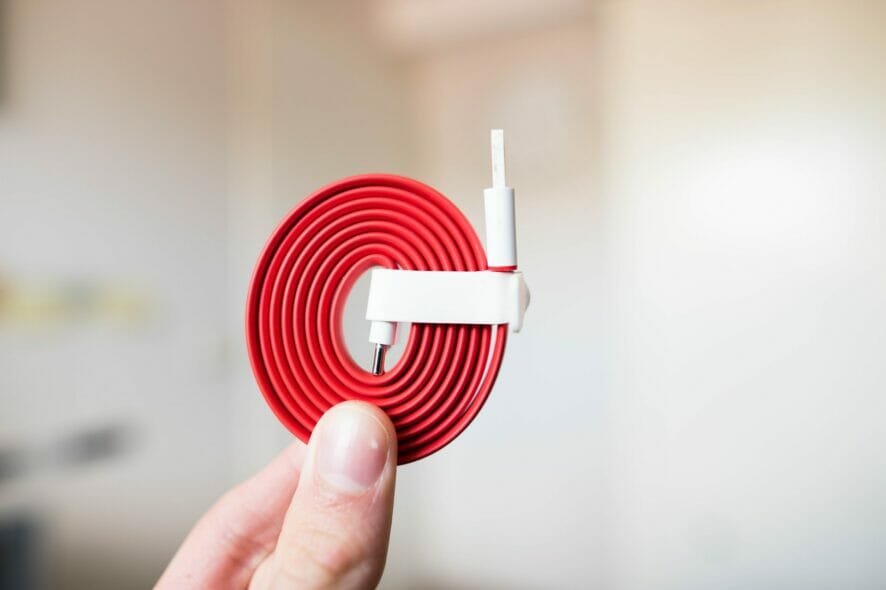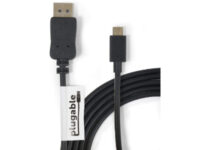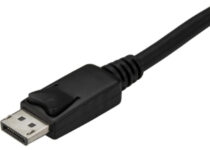3 Best USB-C To Displayport Cables
4 min. read
Updated on
Read our disclosure page to find out how can you help Windows Report sustain the editorial team Read more

USB Type-C interfaces have become common on laptops and desktops due to the sheer versatility this port type offers. You can not only use the Type-C 3.1 port to connect smartphones to your computer and transfer data but also use it to connect external displays and charge other compatible devices.
Not all the monitors come equipped with multiple Type-C ports, nor do the laptops feature multiple DisplayPort or HDMI port.
If you have a laptop with a Type-C port and a monitor with DisplayPort, your best bet is to get a USB C to DisplayPort cable. Fortunately, you can get a USB Type-C to DisplayPort cable for as low as $10.
This article explores the three best USB C to DisplayPort cables to connect your laptop to any DisplayPort enabled monitor to a PC or Mac.
What are the best USB-C to DisplayPort cables?
Accell
- USB 3.1 Type-C to DisplayPort cable
- Enough length for longer connection
- Supports 4K UHD at 60Hz refresh rate
- Only 60Hz support
The Accell USB-C to DisplayPort Cable allows you to send Audio and Video over a single compact cable. This USB C to DisplayPort is capable of transmitting high-definition video and audio from your USB C host to a DisplayPort enabled display.
Accell USB-C cable is compatible with HD to 4K resolution monitors at 60Hz refresh rate. You can use this cable to connect Thunderbolt 3 port on your Macbook, Dell XPS 13, and Galaxy S8.
One end of the cable features a reversible USB 3.1 Type-C connector, while the other features a DisplayPort 1.2 interface. This 6 feet cable is durable and comes with a 2-year limited warranty.
Plugable
- 6ft long durable Type-C to DisplayPort cable
- Supports 4K display resolution at 60Hz
- Plug and Play connection
- Only 60Hz support at 4K
Plugable USB C to DisplayPort is a popular USB Type-C to DisplayPort cable maker. It offers a 6 feet (1.8m) USB Type-C to DisplayPort cable.
This adapter supports resolution up to 4K at 60Hz. You can use this cable to connect your MacBook to an external display or a Windows laptop with a USB Type-C port to an external display. It utilizes the native capabilities of the USB-C port on support computers to drive a DisplayPort monitor up to 4K resolution.
Featuring a plug-and-play operation, Plugable cable is compatible with all the major operating systems, including macOS, Chrome OS, Linux, and Windows systems with USB Type-C 3.1 port.
StarTech
- 3 feet long durable Type-C to DisplayPort cable
- Supports 4K resolution at 60Hz
- Compatible with all major platforms
- Available in multiple lengths
- Expensive
StarTech USB C to DisplayPort Cable is a high performance 3 feet integrated video cable offering male to male connection. It helps in reducing clutter and minimizes signal loss.
The USB 3.1 Type-C can transmit video and audio signals to a DisplayPort enabled monitor in 4K resolution at 60Hz. It is compatible with Dell XPS, Lenovo Thinkpad, Microsoft Surface, Surface Pro, MacBook Pro, iPad Pro, and HP Elite series laptops.
Similar to other USB C to DisplayPort cables, StarTech cable is also compatible with Windows OS, Chrome OS, Android, Linux, and macOS running systems.
The lack of DisplayPort or HDMI options on modern laptops can be annoying as you run out of ports to connect your external displays in no time.
All the USB C to DisplayPort cables listed in this article allow you to use the USB Type-C ports on your laptop to establish a connection to your external monitors through the DisplayPort. These high-quality cables transmit signals without any issues at a higher 4K resolution at 60Hz.
For other useful suggestions on the topic of USB-C cables and devices, don’t hesitate to check these great deals out:
Don’t hesitate to share your experience with us by leaving a comment in the section found below this guide.
[wl_navigator]











